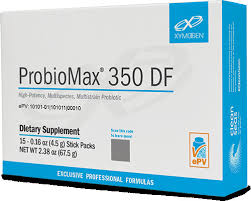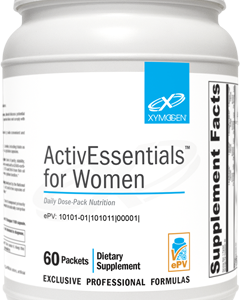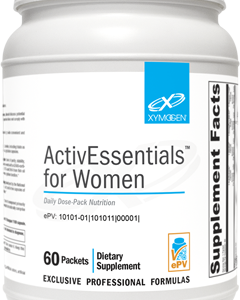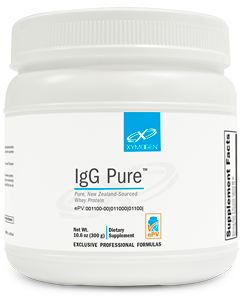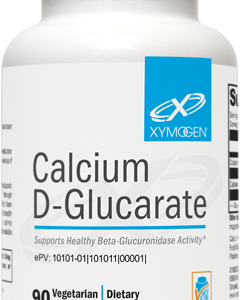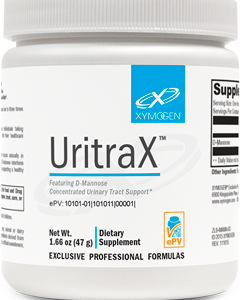Scientific Information/Data
Multiplicity of microbiota species is characteristic of the GI microbiome in healthy individuals, and a loss in species has adverse effects.[1-3] Dietary diversity and taking a variety of probiotic species and strains are methods that help support a healthy microbiome.[1,4] MicroBiome Acute provides 18 different strains belonging to 13 different species of three different genera. The HOWARU and FloraFIT strains that comprise this formula are stable, proven, and trusted worldwide.*
Featured Strains: Bifidobacterium lactis HN019TM and Lactobacillus rhamnosus HN001TM
B lactis HN019 and L rhamnosus HN001 have been studied extensively in vitro and in vivo (in animals and humans) to establish beneficial effects and safety.[5-20] In human research, B lactis HN019 significantly decreased mean whole-gut transit time in adults compared to placebo.[8] Supplementation also had a positive effect on functional GI symptoms, as were self-reported by patient surveys. In a randomized, double-blind, placebo-controlled human dietary intervention study in subjects 60 or more years of age, supplementary HN019 resulted in desirable changes in the intestinal microflora, including significant increases in bifidobacteria and lactobacilli.[13] HN019 has also shown promising effects on parameters of cardiovascular and metabolic health. Compared with baseline and control group values, individuals taking 27 billion CFU had a significant reduction in body mass index, significant improvements in cholesterol and low-density lipoprotein metabolism, and significant decreases in tumor necrosis factor-alpha and interleukin-6.[19] In a three-week study, individuals consuming low-fat/low-lactose milk supplemented with HN019 or HN001 showed increased immune activity when compared to a milk-alone run in.[10] These increases were significantly correlated with age; that is, subjects older than 70 years experienced significantly greater improvements than those under 70 years. Researchers suggest that these results demonstrate the ability of HN019 and HN001 to combat some of the deleterious effects of immunosenescence on cellular immunity.[10] Animal studies demonstrate the ability of HN001 to support natural and acquired immunity as well as promote resistance.[17,18] More recently, human studies have demonstrated HN001’s protective effect on skin health in genetically susceptible individuals.*[7,11]
Other Strains in MicroBiome Acute Have Demonstrated Probiotic Effects in Either In Vitro or In Vivo Research:
- Cause the development of inhibition zones around Clostridium difficile, Salmonella typhimurium, Staphylococcus aureus, Escherichia coli, and Listeria monocytogenes in agar assays*[20]
- Populate vaginal tissue*[21]
- Induce moderate maturation and activation of dendritic cells*[22]
- Degrade oxalates*[23]
- Increase IgA and IgG responses*[25]
- Reduce levels of E coli and enterococcus after antibiotic therapy*[26]
- Help increase and recover numbers of intestinal lactobacilli and/or bifidobacteria*[27] • Promote well-being in relation to intestinal cytokine production*[28,29]
- Improve gastrointestinal health and well-being when under challenge*[27,29]
- Help maintain upper respiratory health*[30]
- Alter the fecal microbiota in obese subjects*[31]
- Maintain healthy fluid balance and integrity of intestinal wall*[32]
- Support intestinal barrier function*[32]
Genetic Testing, Acid and Bile Tolerance, Adhesion
Each of the lactic acid-producing strains in MicroBiome Acute has a history of safe consumption and, based on testing, is regarded to have excellent probiotic potential.[20,33,34] Each bacterium has been genetically characterized and properly classified by independent labs. The organisms have demonstrated tolerance to low pH conditions (hydrochloric acid and pepsin at pH3 for one hour at 37°C), tolerance to bile at concentrations existing in the duodenum, and the ability to adhere to human epithelial cell lines (Caco-2 and HT-29). Adhesion is thought to be an important factor affecting these bacteria’s length of time in the intestines, their ability to modulate immune function, and their ability to take up intestinal “real estate” in competition with other organisms.*[34]
Many of the strains have had additional studies performed, which include testing for the following[20]:
Competitive Inhibition – The ability of probiotics to maintain a healthy microbial balance in the gut is unquestionably important to its usefulness. Probiotics produce inhibitory compounds that limit the growth of other organisms, they compete with other organisms for adhesion sites and nutrients, and they inhibit the production of toxins, among other actions.*
Cytokine and Immune Modulation – Microbiota are key elements in the body’s defense system. Cytokines regulate immune system function, and the ability of many of the strains in MicroBiome Acute to upregulate or downregulate various cytokines has been demonstrated.*
Antibiotic Resistance – Antibiotic susceptibility patterns are an important means of indicating the potential of an organism to be readily inactivated by antibiotics used in human therapy. Importantly, acquired antibiotic resistance or antibiotic resistance transfer have not been detected in any of these strains.*
*These statements have not been evaluated by the Food and Drug Administration. This product is not intended to diagnose, treat, cure, or prevent any disease.
References
- Heiman ML, Greenway FL. A healthy gastrointestinal microbiome is dependent on dietary diversity. Mol Metab. 2016 Mar 5;5(5):317-20. [PMID: 27110483]
- Lloyd-Price J, Abu-Ali G, Huttenhower C. The healthy human microbiome. Genome Med. 2016 Apr 27;8(1):51. doi: 10.1186/s13073-016-0307-y. [PMID: 27122046]
- Xu Z, Knight R. Dietary effects on human gut microbiome diversity. Br J Nutr. 2015 Jan;113 Suppl:S1-5. doi: 10.1017/S0007114514004127. [PMID: 25498959]
- Grimm V, Riedel CU. Manipulation of the microbiota using probiotics. Adv Exp Med Biol. 2016;902:109-17. doi: 10.1007/978-3-319-31248-4_8. [PMID: 27161354]
- Sanders ME. Summary of probiotic activities of Bifidobacterium lactis HN019. J Clin Gastroenterol. 2006 Oct;40(9):776-83. [PMID: 17016131]
- Gopal P, Prasad J, Gill H. Effects of consumption of Bifidobacterium lactis HN019 (DR-10TM) and galacto-oligosaccharides on the microflora of the gastrointestinal tract in human subjects. Nutr Res. 2003;23;1313- 28. http://www.sciencedirect.com/science/article/pii/S0271531703001349. Accessed May 4, 2016.
- Sistek D, Kelly R, Wickens K, et al. Is the effect of probiotics on atopic dermatitis confined to food sensitized children? Clin Exp Allergy. 2006 May;36(5):629-33. [PMID: 16650048]
- Waller PA, Gopal PK, Leyer GJ, et al. Dose-response effect of Bifidobacterium lactis HN019 on whole gut transit time and functional gastrointestinal symptoms in adults. Scand J Gastroenterol. 2011 Sep;46(9):1057-64. [PMID: 21663486]
- Sazawal S, Dhingra U, Sarkar A, et al. Efficacy of milk fortified with a probiotic Bifidobacterium lactis HN019 (DR-10TM) and prebiotic galacto-oligosaccharide in prevention of morbidity—a community based double masked randomized trial. J Pediatr Gastroenterol Hepatol Nutr. Second World Congress; July 3-7, 2004;371-74; Paris, France. http://apiycna.org/wp-content/uploads/2014/01/Sazawal-2004-DR10-and-prebitoic- morbidity.pdf. Accessed May 3, 2016
- Gill HS, Rutherfurd KJ, Cross ML. Dietary probiotic supplementation enhances natural killer cell activity in the elderly: an investigation of age-related immunological changes. J Clin Immunol. 2001 Jul;21(4):264- 71. [PMID: 11506196]
- Wickens K, Stanley TV, Mitchell EA, et al. Early supplementation with Lactobacillus rhamnosus HN001 reduces eczema prevalence to 6 years: does it also reduce atopic sensitization? Clin Exp Allergy. 2013 Sep;43(9):1048-57. [PMID: 23957340]
- Dekker J W, Wickens K, Black P, et al. Safety aspects of probiotic bacterial strains Lactobacillus rhamnosus HN001 and Bifidobacterium animalis subsp. lactis HN019 in human infants aged 0-2 years. Int Dairy J. March 2009;19(3): 149-154. http://www.sciencedirect.com/science/article/pii/S0958694608001787. Accessed May 4, 2016
- Ahmed M, Prasad J, Gill H, et al. Impact of consumption of different levels of Bifidobacterium lactis HN019 on the intestinal microflora of elderly human subjects. J Nutr Health Aging. 2007 Jan-Feb;11(1):26-31. [PMID: 17315077]
- Sheih YH, Chiang BL, Wang LH, et al. Systemic immunity-enhancing effects in healthy subjects following dietary consumption of the lactic acid bacterium Lactobacillus rhamnosus HN001. J Am Coll Nutr. 2001 Apr;20(2Suppl):149-56. [PMID: 11349938]
- Bifidobacterium lactis HN019—a probiotic with proven efficacy. Technical Memorandum 58-1e. Braband, Denmark: Danisco. [on file]
- HOWARUTM Rhamnosus. Technical Memorandum 2053-1e. Brabrand, Denmark: Danisco. [on file]
- Gill HS, Rutherfurd KJ. Immune enhancement conferred by oral delivery of Lactobacillus rhamnosus HN001 in different milk-based substrates. J Dairy Res. 2001 Nov;68(4):611-16. [PMID: 11928957]
- Gill HS, Shu Q, Lin H, et al. Protection against translocating Salmonella typhimurium infection in mice by feeding the immuno-enhancing probiotic Lactobacillus rhamnosus strain HN001. Med Microbiol Immunol. 2001 Dec;190(3):97-104. [PMID: 11827205]
- Bernini LJ, Simão AN, Alfieri DF, et al. Beneficial effects of Bifidobacterium lactis on lipid profile and cytokines in patients with metabolic syndrome: A randomized trial. Effects of probiotics on metabolic syndrome. Nutrition. 2016 Jun;32(6):716-9. [PMID: 27126957]
- Strain Characteristics Reports. Brabrand, Denmark: Danisco. [on file]
- De Alberti D, Russo R, Terruzzi F, et al. Lactobacilli vaginal colonisation after oral consumption of Respecta(®) complex: a randomized controlled pilot study. Arch Gynecol Obstet. 2015 Oct;292(4):861-67. [PMID: 25855055]
- Elawadli I, Brisbin JT, Mallard BA, et al. Differential effects of lactobacilli on activation and maturation of mouse dendritic cells. Benef Microbes. 2014 Sep;5(3):323-34. [PMID: 24913839]
- Giardina S, Scilironi C, Michelotti A, et al. In vitro anti-inflammatory activity of selected oxalate-degrading probiotic bacteria: potential applications in the prevention and treatment of hyperoxaluria. J Food Sci. 2014 Mar;79(3):M384-90. [PMID: 24471378]
- Turroni S, Vitali B, Bendazzoli C, et al. Oxalate consumption by lactobacilli: evaluation of oxalyl-CoA decarboxylase and formyl-CoA transferase activity in Lactobacillus acidophilus. J Appl Microbiol. 2007 Nov;103(5):1600-09. [PMID: 17953571]
- Paineau D, Carcano D, Leyer G, et al. Effects of seven potential probiotic strains on specific immune responses in healthy adults: a double-blind, randomized, controlled trial. FEMS Immunol Med Microbiol. 2008 Jun;53(1):107-13. [PMID: 18422632]
- Luo X, Lun Y, Gao W, et al. Effects of spent culture supernatant of Lactobacillus acidophilus on intestinal flora in mice with antibiotic-associated diarrhoea [in Chinese]. World Chinese J Digestology. 2006;14(19):1870-73. http://en.cnki.com.cn/Article_en/CJFDTotal-XXHB200619005.htm. Accessed May 16, 2016.
- Bartosch S, Woodmansey EJ, Paterson JC, et al. Microbiological effects of consuming a synbiotic containing Bifidobacterium bifidum, Bifidobacterium lactis, and oligofructose in elderly persons, determined by real-time polymerase chain reaction and counting of viable bacteria. Clin Infect Dis. 2005 Jan 1;40(1):28-37. [PMID: 15614689]
- Foligne B, Nutten S, Grangette C, et al. Correlation between in vitro and in vivo immunomodulatory properties of lactic acid bacteria. World J Gastroenterol. 2007 Jan 14;13(2):236-43. [PMID: 17226902]
- Collado MC, Meriluoto J, Salminen S. Role of commercial probiotic strains against human pathogen adhesion to intestinal mucus. Lett Appl Microbiol. 2007 Oct;45(4):454-60. [PMID: 17897389]
- West NP, Horn PL, Pyne DB, et al. Probiotic supplementation for respiratory and gastrointestinal illness symptoms in healthy physically active individuals. Clin Nutr. 2014 Aug;33(4):581-87. [PMID: 24268677]
- Larsen N, Vogensen FK, Gøbel RJ, et al. Effect of Lactobacillus salivarius Ls-33 on fecal microbiota in obese adolescents. Clin Nutr. 2013 Dec;32(6):935-40. [PMID: 23510724]
- Elian SD, Souza EL, Vieira AT, et al. Bifidobacterium longum subsp. infantis BB-02 attenuates acute murine experimental model of inflammatory bowel disease. Benef Microbes. 2015;6(3):277-86. [PMID: 25391346]
- Kailasapathy K, Chin J. Survival and therapeutic potential of probiotic organisms with reference to Lactobacillus acidophilus and Bifidobacterium spp. Immunol Cell Biol. 2000 Feb;78(1):80-88. [PMID: 10651933]
- Tuomola E, Crittenden R, Playne M, et al. Quality assurance criteria for probiotic bacteria. Am J Clin Nutr. 2001;73(suppl):393S–98S. http://ajcn.nutrition.org/content/73/2/393s.full.pdf+html. Accessed May 16, 2016.


